
Our team
A multilingual and cross-cultural team of Deaf and hearing researchers examined, for the first time, the impact on wellbeing, agency and identity of a consistent and life-long experience of Deaf people being known through interpreters. Then, four Deaf-artists-in-residence explored and created visual arts representations of the Translated Deaf Self in diverse contexts where in everyday life this is encountered.
Use the menu and navigate through their profiles to know more about their roles and experience as part of “The Translated Deaf Self” Project.
Meet the Artists
Rubbena Aurangzeb-Tariq
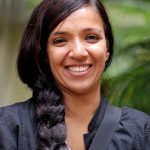 Rubbena Aurangzeb-Tariq is a British-Pakistani Deaf Artist based in London. She has exhibited in the UK and internationally and has been interviewed on the BBC, Channel 4 and BSL Zone about her work.
Rubbena Aurangzeb-Tariq is a British-Pakistani Deaf Artist based in London. She has exhibited in the UK and internationally and has been interviewed on the BBC, Channel 4 and BSL Zone about her work.
Rubbena art practice reflects her life’s journey of stories exposing the tensions between multiple identities and contemporary cultures. She creates abstract and contemporary paintings to express her sense of emotional attachment and the impact of the cultural diversity that she is immersed in. She deploys a language of colour and texture to describe hidden elements and multiple layers of our inner selves.
Rubbena was commissioned for the Translating the Deaf Self project and was artist in residence in London (Deafplus, Whitechapel) and Manchester (Manchester Deaf Centre). Working with a deaf community who are migrants and immigrants who have moved to the Western world,they shared their stories of having to learn a new language, and adapt to a new culture. Their experience of being translated often leaves them feeling uncertain about what is being said, and lacking confidence to ask for clarification when translations are unsuccessful in bridging cultural divides.
Rubbena felt the process of creating a visual ‘artistic translation’ was a real challenge to her practice and was like a test of the possibility of successfully rendering experiences artistically. She met the challenge by forcing herself to adapt her practice to find a new method, using colour as a visual metaphor to focus on the nature of translation. At times Rubbena felt a weight of responsibility exercising technical care and control in ensuring she presented a visual translation which could do justice to the members of the Deaf community who had generously shared their experience.
Rubbena has developed a 2D installation of paintings structured with the language of colour to express a sense of incoherence, dislocation and uncertainty in translation.
Louise Stern
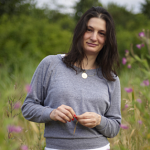 I use the written word and visual images to examine language, emotion, and communication.
I use the written word and visual images to examine language, emotion, and communication.
My work includes two books of fiction (pub. Granta), short stories commissioned by Granta Magazine, Radio 4, the Garage Museum of Contemporary Art, and the Royal Academy Magazine, a short narrative film for Film 4 as writer and director, and art exhibited in Geneva, Madrid, Barcelona, Istanbul, Paris, New York, and London among other places. I also work in dance and theatre.
Christopher Sacre
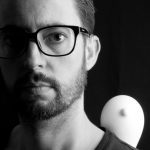
Christopher Sacre studied BA (Hons) Fine Art Sculpture at Wolverhampton University. His 2010 installation ‘See What This Man Gave Birth to After Using 2000 Condoms in 22 Days’ marked a creative turning point as his work shifted from more traditional, nature-related sculpture to the conceptual. Energised by the success of this piece Christopher created a further sculptural evolution of his ‘condom’ cast work culminating in his solo 2014 exhibition ‘NOTHINGNESS’ – winner of the 2014 FPS Roy Rassmussen Award. Christopher has continued to explore the possibilities of his sculptural forms whilst pushing his work into unfamiliar territory with drawings, paintings and prints. In 2015 Christopher moved into the realm of public art installation with Aperture Project, a participatory work in Rochester, Kent created in collaboration with sound artist Stuart Bowditch. Christopher also works extensively with museums and galleries around the country delivering creative workshops for both deaf and hearing people. In 2016, Christopher established SEE and CREATE, enabling Deaf Families to have greater opportunity to participate in accessible family-friendly creative events. And co-founded the MESS ROOM, a creative community hub with a special emphasis on providing access to creative events for Deaf, Blind and Partially-Sighted people. Based at Sun Pier House in Chatham, Kent it offers a wide range of creative activities working in partnership with skilled local artists to ensure diversity and choice in their offer.
Photography – Sara Norling.
Visit Christopher’s portfolio and personal website.
Ruaridh Lever-Hogg
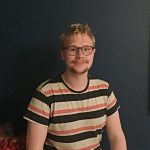 Ruaridh is a Scottish artist and spend most of his life in Highland rural countryside. Recently he graduated the Master Fine Art & Humanities in University of Dundee. Currently, he’s working in Glasgow to explore the new ideas and meet the community from the location to other location to find the inspiration.
Ruaridh is a Scottish artist and spend most of his life in Highland rural countryside. Recently he graduated the Master Fine Art & Humanities in University of Dundee. Currently, he’s working in Glasgow to explore the new ideas and meet the community from the location to other location to find the inspiration.
Exploring and experimenting with materials to use in his work is important to me as an artist, He’s using materials that are highly visual to the senses and evoke memory.
Primarily using Oil paints allowed him to fill a space on canvas with thoughts, emotion, and stillness in a highly visual manner. Learning a new technique of expression, painting allowed to focus without interference, freeing his mind to think and express, to look closer and examine the medium, subject and form.
Producing work aimed at provoking discussion to ideas that he thinks about the physical and emotional state of being inspired him to examine myself as well as subject.
Creating work with the aim of provoking a strong emotional response or debate from the viewer inspires me, I feel drawn to producing work containing visual elements that allow the viewer clearer understanding of my ideas.
Visit Ruaridh’s portfolio and personal website.Researchers team
Alys Young
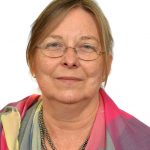 I am social scientist who has worked in sign language and deafness for the past 30 years. I have a special interest in applied health and social studies and many of my projects have focussed on quality of life and better services for deaf children and adults.
I am social scientist who has worked in sign language and deafness for the past 30 years. I have a special interest in applied health and social studies and many of my projects have focussed on quality of life and better services for deaf children and adults.
I convene the Social research with Deaf people group (SORD) at the university of Manchester where I am also Professor of Social Work. I am also distinguished visiting professor at the Centre for Deaf Studies at the University of the Witwatersrand, South Africa. Over the past 10 years SORD has been awarded over £10m in research funding and I have held grants from AHRC, ESRC, MRC, NIHR, GCRF and many non-governmental research bodies. A full list of publications is available via my research profile pages.
I was conferred FAcSS in 2015 (Fellow of the Academy of Social Sciences) in recognition of my thought leadership in this field and in 2016 won the Times Higher Education national award as Outstanding Research Supervisor or the Year. I remain a qualified and registered social worker.
Visit Alys Young’s research profile at The University of Manchester site.
Jemina Napier
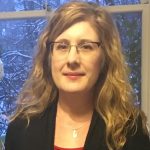 Professor Jemina Napier is Chair of Intercultural Communication and Director of the Centre for Translation & Interpreting Studies in Scotland, in the Department of Languages & Intercultural Studies, School of Social Sciences at Heriot-Watt University in Edinburgh, UK. She is also a Visiting Professor at the Centre for Deaf Studies at Trinity College Dublin, and Adjunct Professor in the Department of Linguistics at Macquarie University, Sydney, Australia.
Professor Jemina Napier is Chair of Intercultural Communication and Director of the Centre for Translation & Interpreting Studies in Scotland, in the Department of Languages & Intercultural Studies, School of Social Sciences at Heriot-Watt University in Edinburgh, UK. She is also a Visiting Professor at the Centre for Deaf Studies at Trinity College Dublin, and Adjunct Professor in the Department of Linguistics at Macquarie University, Sydney, Australia.
Her research focuses on sign language intercultural communication, conducting linguistic, social and ethnographic explorations of direct and interpreter-mediated communication to inform intercultural communication, interpreting studies, applied linguistics, and deaf studies theories. Her specialist language is British Sign Language, and she is fluent in Australian and American Sign Languages and International Sign. Jemina was founding editor of the International Journal of Interpreter Education and is on the editorial board for the International Journal of Translation & Interpreting Research and the Journal of Deaf Studies & Deaf Education. She has published over 100 books, edited volumes, and peer-reviewed book chapters and journal articles, which are widely cited in signed and spoken language interpreting studies publications.
Jemina has led or been involved in projects totaling over £1 million in grant funds, and actively engages with professional associations and Deaf communities at national and international levels. She is Co-Chair of the European Forum of Sign Language Interpreters’ Committee of Experts; WFD Accessibility Expert Group member.
Visit Prof. Jemina Napier Research Profile at Heriot Watt University.
Katherine Rogers
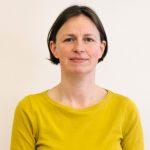 Katherine is a Research Fellow and has been involved in the Social Research with Deaf people (SORD) group at the University of Manchester since 2006. She has completed a Doctoral Research Fellowship, funded by the National Institute for Health Research. Her research interests primarily involve issues pertaining to Deaf communities and their families, especially those which promote more positive outcomes. Examples of research projects she has been involved in include Deaf role models, the mental well-being of d/Deaf people, evaluating the effectiveness and cost-effectiveness of BSL IAPT, and the validation of standarised psychometric instruments with d/Deaf populations. A full list of publications can be found at Katherine’s research profile.
Katherine is a Research Fellow and has been involved in the Social Research with Deaf people (SORD) group at the University of Manchester since 2006. She has completed a Doctoral Research Fellowship, funded by the National Institute for Health Research. Her research interests primarily involve issues pertaining to Deaf communities and their families, especially those which promote more positive outcomes. Examples of research projects she has been involved in include Deaf role models, the mental well-being of d/Deaf people, evaluating the effectiveness and cost-effectiveness of BSL IAPT, and the validation of standarised psychometric instruments with d/Deaf populations. A full list of publications can be found at Katherine’s research profile.
Rosemary Oram
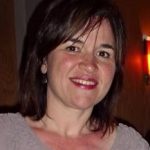 Rosie was employed by SORD for 8 years as a Research Assistant/Research Associate. Prior to her current role, the most recent research project in which she was involved was ‘Translating the Deaf Self’, funded by the Arts & Humanities Research Council (AHRC).
Rosie was employed by SORD for 8 years as a Research Assistant/Research Associate. Prior to her current role, the most recent research project in which she was involved was ‘Translating the Deaf Self’, funded by the Arts & Humanities Research Council (AHRC).
Previous research projects have included deaf people in social work, education for young deaf people, BSL-IAPT evaluation, and also older deaf people considering care options Furthermore, Rosie has carried out a number of consultations including one for the RAD (Royal Deaf Association) in relation to their services, and one for the NDCS (National Deaf Children’s Society) on the availability of educational resources for deaf young people.
At present, Rosie is part of a project, the aim of which is , to further investigate the cultural and social impact of translation on Deaf people who use sign language. Her role is to work alongside the artists, collecting and analysing data, and to be involved when a final product from each of the artists is being exhibited to the public.
In addition, she is currently in her first year of doctoral training (part-time) in social work at the University of Manchester. The study will involve the exploration of parenting assessments in relation to safeguarding in instances where one or more parent is a Deaf BSL (British Sign Language) user.
Zoë McWhinney
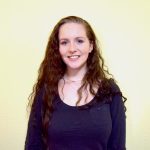 After briefly interning in Deafness, Cognition and Learning (DCAL)’s project on linguistic dexterity in summer of 2013, Zoë went to study BA International Relations with Political Science at University of Birmingham whilst also working as a research assistant for Multimodal Multilingual lab led by Robin Thompson. She also worked as a research assistant for the final phrase of Translating the Deaf Self’s original scoping study project in 2016, replacing Noel O’Connell. She is currently a part-time research assistant/project link worker for the second phrase commissioning Deaf artists.
After briefly interning in Deafness, Cognition and Learning (DCAL)’s project on linguistic dexterity in summer of 2013, Zoë went to study BA International Relations with Political Science at University of Birmingham whilst also working as a research assistant for Multimodal Multilingual lab led by Robin Thompson. She also worked as a research assistant for the final phrase of Translating the Deaf Self’s original scoping study project in 2016, replacing Noel O’Connell. She is currently a part-time research assistant/project link worker for the second phrase commissioning Deaf artists.
Visit Zoë McWhinney’s academic profile.
Francisco Espinoza
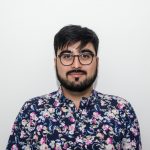 Francisco is a Sociologist and has a MSc in Political Science from the University of Chile. His previous work has focused on policies and local government, analysis on reform process, health planning strategies and community oriented interventions. In this project he has been responsible for web presence and digital communication.
Francisco is a Sociologist and has a MSc in Political Science from the University of Chile. His previous work has focused on policies and local government, analysis on reform process, health planning strategies and community oriented interventions. In this project he has been responsible for web presence and digital communication.
